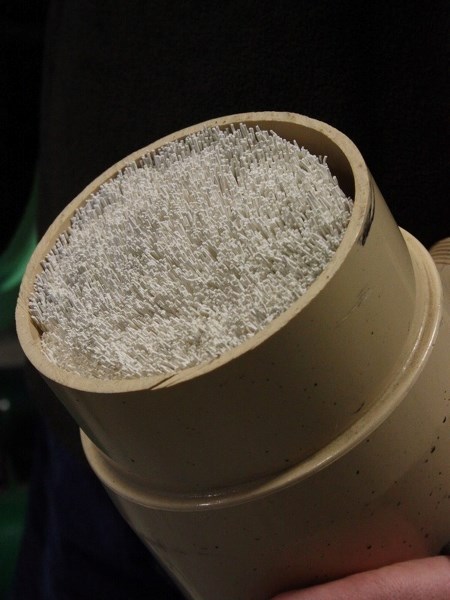The acting chief administrative officer for the Aspen Regional Water Services Commission (ARWSC) said town and county residents’ drinking water is safe despite a plume of at least 670 million litres of coal slurry recently passing town via the Athabasca River, the commission’s water source.
“The water is safe to drink. We drink it all the time,” said commission CAO Gary Buchanan.
Alberta’s chief medical officer of health has also stated the water is safe to drink so long as it has been processed at a water treatment plant.
The slurry, which spilled from a holding pond at the Obed Mountain mine near Hinton on Oct. 31 and eventually entered the river, contained sediment laced with contaminants including mercury, lead and arsenic.
The commission shut off its intake from the river from Nov. 10 to Nov. 20 (before, during and after the plume passed), and Buchanan said the “ultra-modern” water treatment plant is well equipped to deal with any contaminants lingering in the water.
“We’re always very conscious of ensuring that we deliver quality water to the residents,” said Buchanan, adding that the plant, which serves Athabasca, Boyle, Grassland, Colinton and Wandering River, is likely one of the most modern ones in the province.
Dr. Kevin Timoney of Treeline Ecological Research, who has studied the Athabasca River and has experience with a water treatment plant near Fort MacKay, said computerized water treatment plants work well so long as the software is being utilized properly.
Buchanan said the ARWSC plant has a lab in which employees run their own tests to ensure the computer readings are accurate.
While the ARWSC tests for variables like pH, turbidity and chlorine levels in-house, tests for contaminants like trace metals and mercury would have to be conducted at labs elsewhere, Buchanan said.
As for whether the commission will send its treated water for any additional testing in light of the spill, Buchanan said that’s up to the province. Water plants operate under licenses administered by Alberta Environment and Sustainable Resources (ESRD) and must adhere to license stipulations, he said, including what is tested for and when.
So far, said Buchanan, the province has not asked the plant make any changes to its operations, nor has it instructed the commission to send water for more comprehensive tests.
“If we’re required to make changes to ensure health and safety, then we make those changes,” he said.
The plant’s water is sent for a full suite of tests two times a year, said Buchanan. Most recently, samples were tested in August, and the next round is scheduled for February.
Timoney said the plant’s water may well be fine to drink, but the government should be sending it for more tests.
The ESRD has released some test results for river water, though none from samples near Athabasca.
“That’s something the townspeople may want to bring to the ESRD’s attention, because that is a huge unknown,” said Timoney. “There’s a difference between sampling at certain points along the river and sampling people’s water supply.”
Timoney pointed out that most of the contaminants from the slurry spill are affixed to sediment, and while the ESRD has released some water quality data, no sediment test results have been released as of press time.
“If it turns out that the contaminants that they are finding in the sediment are still a cause for concern a week or two or three weeks from now, then this is something that the water treatment plants should push for. There should be water samples analyzed in a good laboratory,” said Timoney.
He said tests for most heavy metals cost “less than a tank of gas” and added that perhaps the industry responsible for the spill should pay.
Timoney said sediment that has settled on the riverbed could remobilize during “pulses” of high flow in the spring and during storms.
“Just because that initial plume may have passed the community doesn’t mean this event is over. This event may go on for years,” he said.
Buchanan said debris in the river is always a concern during spring runoff, but the raw water pumphouse eliminates many solids from the get-go.
“Within that process, there’s a number of centrifuges that spin the water and push the solids out, and so it’s a form of settling,” said Buchanan. “When it’s brought up the hill here, you have a lower percentage of any solids in the river. So that’s just an ongoing process already.”
He added that the commission has shut off river intake during past springs when debris levels are high.
“If we need to, yes, we would do that,” he said.
Timoney acknowledged that the contaminants being affixed to sediment could be a boon to treatment plants, as it could make the toxins easier to strain out.
Buchanan said the commission has exercised the utmost caution. As soon as the commission was alerted to the spill, around 8 or 9 p.m. on Oct. 31, it shut off the river intake. Once the ARWSC got more information, said Buchanan, the intake was opened again until the plume was within a day or so of arriving in Athabasca. Then, the intake was shut off for 10 days and was only reopened when the province said it was safe to do so.
Timoney said while he cannot speak to the ARWSC plant’s water quality, in general, “There are unknowns that need to be addressed, and the only people that can address those are the government.”
Buchanan said he is confident any threat to the water supply passed with the plume.
“What you’re getting now is normal river water to this time of year,” he said.


